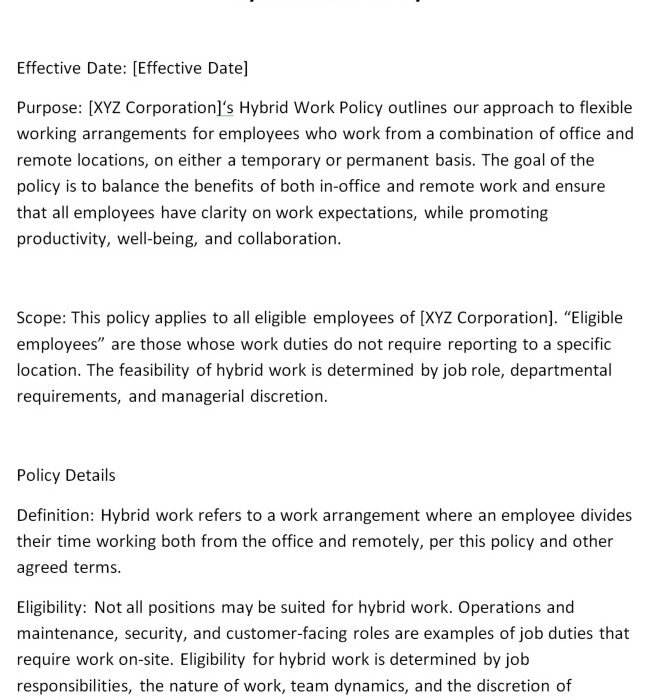Hybrid work has become a staple in the modern workplace, blending the best of remote and in-office environments. For organizations navigating this new norm, a hybrid work policy is essential to ensure clarity, fairness, and productivity. In this guide, we will cover everything you need to know about creating a hybrid work policy template, including its purpose, components, and best practices.
What Is a Hybrid Work Policy?
A hybrid work policy is a formal document outlining the framework, expectations, and guidelines for employees who split their work between remote and office settings. This policy ensures consistency, transparency, and alignment with company goals while catering to the flexibility needs of employees.
Why Do You Need a Hybrid Work Policy?
A well-structured hybrid work policy provides:
- Clear expectations: Employees understand their responsibilities, work schedules, and communication protocols.
- Fairness: Ensures equal opportunities and prevents favoritism.
- Productivity: Offers guidelines for maintaining performance and accountability.
- Compliance: Meets legal and regulatory requirements related to remote work.
Key Components of a Hybrid Work Policy Template
Here are the essential elements to include in your hybrid work policy:
1. Purpose and Scope
- Define the goals of the policy and who it applies to.
- Example: “This policy applies to all full-time employees eligible for hybrid work arrangements based on their roles and responsibilities.”
2. Eligibility Criteria
- Specify which roles are eligible for hybrid work.
- Example: “Hybrid work is available for roles that do not require daily in-office presence, such as administrative, technical, and creative positions.”
3. Work Schedule Guidelines
- Outline the expected in-office and remote work days.
- Example: “Employees must work from the office at least two days a week, with flexibility on specific days based on team needs.”
4. Communication Expectations
- Define protocols for meetings, updates, and team collaboration.
- Example: “Employees should be available on Slack and email during standard business hours, and all team meetings will occur via Zoom every Monday.”
5. Equipment and Tools
- Clarify who is responsible for providing equipment.
- Example: “The company will provide laptops and monitors for remote work, while employees are responsible for ensuring a reliable internet connection.”
6. Productivity and Performance Metrics
- Set expectations for tracking work output.
- Example: “Managers will evaluate performance based on project deadlines, task completion, and team feedback.”
7. Cybersecurity and Data Protection
- Outline measures to ensure secure work practices.
- Example: “Employees must use company-provided VPNs and follow IT guidelines to protect sensitive data.”
8. Health and Safety Requirements
- Address ergonomic and safety considerations for remote setups.
- Example: “Employees are responsible for creating a safe and ergonomically sound home office.”
9. Reimbursement Policies
- Specify costs covered by the company.
- Example: “The company will reimburse up to $50 monthly for internet expenses for eligible employees.”
10. Review and Feedback Mechanism
- Include a process for reviewing the policy.
- Example: “This policy will be reviewed annually, with employee feedback gathered through anonymous surveys.”
Steps to Create Your Hybrid Work Policy Template
Follow these steps to develop an effective hybrid work policy:
Step 1: Assess Business Needs
- Identify the roles that can work remotely and the minimum in-office requirements to maintain productivity.
Step 2: Engage Stakeholders
- Involve HR, team leaders, and employees to gather diverse perspectives.
Step 3: Draft the Policy
- Use the components outlined above as a foundation. Be clear and concise.
Step 4: Review Legal Requirements
- Consult legal experts to ensure compliance with labor laws and remote work regulations.
Step 5: Communicate the Policy
- Share the policy with all employees, ensuring clarity through training or Q&A sessions.
Step 6: Monitor and Update
- Continuously monitor the effectiveness of the policy and make improvements based on feedback and changes in work dynamics.
Best Practices for Implementing a Hybrid Work Policy
1. Prioritize Flexibility
- Offer employees options that align with their personal needs while meeting business goals.
2. Promote Communication
- Encourage open communication and ensure all team members stay connected, regardless of location.
3. Foster Inclusivity
- Avoid creating a divide between remote and in-office employees by ensuring equal opportunities for growth and recognition.
4. Provide Training
- Equip managers and employees with skills to thrive in a hybrid work environment, such as remote collaboration tools and time management.
5. Regularly Evaluate Success
- Use KPIs like employee satisfaction, productivity levels, and retention rates to measure the success of your policy.
hybrid work policy template
External Resources
- Harvard Business Review: Managing Hybrid Teams Effectively
- SHRM: Legal Considerations for Hybrid Work Policies
- Forbes: Best Practices for Hybrid Work
Frequently Asked Questions (FAQs)
It provides clarity, fairness, and structure to ensure employees and organizations can operate efficiently in a hybrid environment.
By clearly defining eligibility criteria, expectations, and performance metrics while fostering inclusivity.
Collaboration tools like Slack, Zoom, project management platforms like Asana or Trello, and secure IT infrastructure.
Ideally, review the policy annually or whenever significant changes occur in the workplace dynamics.
Compliance with labor laws, data protection regulations, and health and safety standards for remote setups.




![20+ Free Information Security Policy Templates [Word, PDF] safeguarding customer information security policy template](https://templatedata.net/wp-content/uploads/2021/07/safeguarding-customer-information-security-policy-template-150x150.jpg)


![Free Policy Proposal Templates & Examples [Excel, Word, PDF] free policy proposal template 5](https://templatedata.net/wp-content/uploads/2021/08/free-policy-proposal-template-5-150x150.jpg)


![Free Disciplinary Action Form Templates [Word] free disciplinary action form 5](https://templatedata.net/wp-content/uploads/2021/08/free-disciplinary-action-form-5-150x150.jpg)




